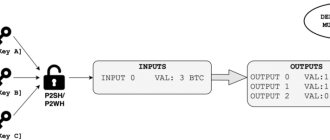Cryptocurrencies and the blockchain industry provide enormous opportunities for earning money even for users without starting capital. By investing in a project at an early stage, after the official entry into the market, you can increase your investment by at least 2-50 times. For example, at the ICO stage the price of the IOTA token was slightly more than 0.0004 USD, and today this figure reaches 0.24 USD. It is easy to calculate that the return on investment in this case is 13,000% per annum.
But the market also offers other investment solutions that do not require analysis of each blockchain startup. Cryptocurrency landing page, according to the creators, allows you to earn daily from 1% of invested BTC, ETH or USD. There are also Bitcoin faucets where you can earn parts of BTC without investing any money at all. By choosing the most profitable offers, with a rational approach, you can earn money for an apartment or an expensive car in a few years.
Among the variety of earning schemes, fraudulent projects are often found. By investing in one of these, you risk not only receiving zero return, but also completely losing all your invested funds. In the digital money environment, such schemes are called scams. To prevent you from losing your investment, it is important to recognize scam cryptocurrencies in time and understand how scammers work.
What is SCAM
Scam (from the English scam - scam, fraud) is an investment project, a blockchain startup that has stopped paying dividends and their investments to users, or did not initially pay them. It is understood that the attackers who launched the project not only deprive the investor of interest, but also steal the entire invested amount. For the first time, the term began to be used in relation to cryptocurrency landing, but then spread to other earning schemes.
All scams work according to a similar scheme: first they promise users income from investments or an innovative project on the blockchain, and later they disappear along with the invested funds. Scam is based on human psychology. There will always be a small number of people with an entrepreneurial spirit who will want to take a risk and invest in a highly profitable project. It is also worth noting that attackers take advantage of people’s lack of technical knowledge regarding cryptocurrencies and digital technologies. Such novice investors believe that they have found the fastest and most convenient way to make money.
In fact, investing turns into a nightmare - after a couple of weeks of accrual of interest (which can only be withdrawn after a certain period), the site stops working, and the investor is left with nothing. Additional imaginary reliability is created by hundreds of laudatory reviews about the project on the Internet, beautiful website design and an active advertising campaign. An unenlightened user simply does not believe that after spending such a large amount on promotion, the project will cease to exist overnight. As a result, the income of scammers from “newbies” is many times higher than the amount spent on advertising and buying laudatory reviews.
The basis of the work of scams is that the status of cryptocurrencies in many countries has not yet been determined. If the issue of digital money is not within the legal framework of the state, then there is no point in talking about investment projects based on cryptocurrency. But even with the help of the state, regulating this issue is problematic: companies are registered in countries with a free economic zone, all payments are made in cryptocurrency, and the creators cannot be tracked. The earning scheme is so well thought out that special domains are created, uncontrolled domains, and even after blocking, access to the site is possible using a VPN or a mirror.
Most often, cryptocurrency scams take the following form: they imitate an analogue of an investment fund, but for cryptocurrencies. The creators offer the user to transfer digital money to the fund, which will be invested in exchange trading and large ICO projects. It is believed that the high volatility of cryptocurrencies and their active growth make it possible to receive huge profits (which, however, are not disclosed), and the investor’s interest is 1-3% daily. At the same time, some users actually withdraw investments from sites, increasing investments by 1.5-2 times. The scheme seems plausible, but in reality, scammers do not trade on exchanges, but simply actively accumulate users’ money. Casual investors are allowed to withdraw funds - the loss of this money will be insignificant compared to the total mass of defrauded users.
Despite all the restrictions and advice from the Ministry of Economy of the Russian Federation, the Council of the EU, and the US Securities and Exchange Commission, people continue to invest in unprofitable projects. Moreover, the problem takes on the status of gambling - even realizing the risks of such projects, people strive to quickly withdraw investments from there with interest, while the site “pays”. Enthusiasts create interactive catalogs of existing cryptocurrency funds, where the status of the project is tracked online. Such investment cryptocurrency funds, on which the bravest investors are trying to make money, are called hypes (from the English hype - deception, deception, unjustified advertising), comparing them to economic bubbles.
Reasons for scam
Not all companies on the Internet operate honestly. This applies not only to HYIPs, but also to different brokers. They disguise themselves as bona fide organizations in order to get as much money as possible from users, and then close the project. This is a typical example of scam. Let's look at the most common reasons for bankruptcy, which are used as a screen.
Manager's incompetence
The company may declare that depositors' funds were lost as a result of the manager's unsuccessful activities in the financial market. Investors generally do not have the tools available to verify such claims. It is quite possible that the transactions were not carried out by the company at all, and the client’s funds were immediately withdrawn from the system.
Hacker activity
Some scammers try to illegally obtain depositors' funds through company advertising, while others deliberately hack into accounts in order to transfer funds to their own funds. This creates a pretext for blaming hackers for their bankruptcy.
In current practice, this reason for scam is used quite rarely. According to the rule of most brokers and HYIPs, funds can only be withdrawn to the account that was used when making the deposit. Conscientious companies store client funds in separate accounts, which also reduces the likelihood of hacking and money theft to a minimum.
The fault of the financial partner (provider)
If we are talking about brokers who want to take over clients’ money, then they can hide behind their providers. In most cases, their financial partner is a fake organization that was created by the same founders as the broker.
Types of SCAM
To fully answer the question of what SCAM is in cryptocurrencies, we should look at the main types of fraud. Over the entire existence of the market, tens of thousands of projects have been implemented. It is necessary to distinguish in advance between failed startups and business models and fraudulent schemes. According to statistics, only 10% of the total number of launched projects entered the active development stage. But this does not mean that the remaining 90% are a scam and an attempt to make money on gullible users.
Scam projects take on a variety of forms. Literally every year, scammers develop a new concept that allows them to make money from unenlightened crypto enthusiasts. It is important to talk about the types of such fraud in order to understand the general principle of how scam works.
Fraudulent ICO
One of the first types of scams in the cryptocurrency environment. ICO, or initial coin offering, is an analogue of an IPO for the world of digital currencies, which allows you to collect investments for the implementation of a promising project on the blockchain. The concept of ICO owes its appearance to the Ethereum cryptocurrency and smart contracts. ETH technical protocols made it possible to create an ICO based on this coin. Therefore, in the cryptocurrency environment, investment fees became actively widespread only after 2020.
The essence of the ICO: users purchase a project token at a fixed price, which is regarded as an investment. A token is a kind of bond in the world of digital money, which, after the implementation of the project, is released to the open market and actively traded on exchanges. So, having bought a token at a fixed price, you can then sell it at a higher market value. Therefore, ICO is considered as a key investment tool in cryptocurrencies.
But not all ICO projects reach the stage of bringing the company to the open market. Many never accumulate the necessary amount to implement a startup or encounter unexpected technical difficulties. Another common obstacle is the occasional decline in the cryptocurrency market, which greatly reduces the effectiveness of the investment (most of the amount is collected in ETH or BTC). Most often, conscientious creators return their investments to users if the project fails. But often users invest in a startup at their own peril and risk.
A fraudulent ICO implies that the creators do not initially intend to implement a project based on cryptocurrencies. The main goal of such a company is to collect more money from users in cryptocurrencies, so that they can then disappear without a trace with their savings. At the same time, a beautiful company website is organized, original documentation is created: Whitepaper and Roadmap of the project. Such ICOs completely borrow the technical description of the project and the idea from other successful startups. It is difficult for inexperienced users to notice the catch if they were not previously familiar with blockchain startups. Therefore, fraudulent ICOs often collect 1-20 million rubles in the form of cryptocurrency, after which the project is frozen.
Cryptocurrency landing page or hype project
Another popular type of scam. Hype is the general name for a fraudulent project advertised in the form of an investment fund. In theory, cryptocurrency landing is not always a fraudulent project. Essentially, this is a form of credit where one user gives part of their savings to another at a certain percentage. The recipient undertakes to pay the entire amount along with interest.
Such lending relationships could be implemented using a smart contract, but most blockchain projects imply that the transfer of cryptocurrency is irreversible. This means that, within the framework of modern protocols, it is impossible to legally return the loan amount along with interest. Because of this, cryptocurrency landing takes the form of a trusting relationship. Fraudsters quickly took advantage of this, and the status of lending and lending with digital assets was undermined.
A cryptocurrency landing page rather represents a relationship between two independent users. Therefore, scammers came up with a more advanced method of collecting money from a large number of users at once - investment landing. It is believed that the organizers, represented by several experienced cryptocurrency investors and traders, will effectively use your investments, achieving returns of 500-1000% per annum (as is known, this is not uncommon in the digital asset market). Therefore, they offer users 1% return daily or about 365% per year. At the same time, the initial investment amount is small - about 3-5 thousand rubles in the form of BTC or other cryptocurrency. Of course, such an offer seems beneficial to the majority of users who were not previously familiar with the features of the cryptocurrency market. In 3 months, the invested 15 thousand rubles will turn into 30, which is not guaranteed by any modern bank or investment fund.
Cryptocurrency hype is possible due to a typical logical error of users. Yes, ROI of 500% and even more is found in the digital asset market. All the media write about such highly effective startups or the rapid growth of the cryptocurrency rate - a successful project is constantly in the news. Because of this, it seems that such profitability is the norm for the cryptocurrency world. In fact, no more than 1-10% of the total number of startups achieve success. Therefore, the chance of multiplying your investments is not as great as it seems at first glance. And the cryptocurrency hype itself is a typical financial pyramid.
The very concept of cryptocurrency investment funds does not seem to be a losing proposition in advance. Guided by logic, analyzing each project and investing in certain digital assets on time, you can achieve high returns. But due to the lack of traditional exchange rate analysis tools and high volatility, the investment risks remain too great. Therefore, it is easier for skillful investors to maintain a personal investment portfolio than to be responsible for the funds of other users.
Bitcoin faucets
A more sophisticated and difficult to implement scam project. The idea is that the user receives a small denomination of BTC in exchange for watching ads, solving captchas or other actions. After accumulating a certain amount, he can withdraw coins, earning a small amount (usually 5-50 dollars) without investment.
The Bitcoin coin can be divided into smaller components, similar to dividing the US dollar into cents. Moreover, the minimum BTC size is 10 to the power of minus 8. This denomination is called “satoshi” or “satoshi”, in honor of the hypothetical creator of Bitcoin, Satoshi Nakamoto.
For viewing advertisements on Bitcoin faucets, a user can receive from 100 to 100,000 satoshi per hour. With due diligence, you can accumulate a decent amount in a few months and withdraw it. Cryptocurrency is issued from a general fund, which amounts to several BTC. At the same time, the cost of charging satoshi does not exceed advertising income. Because of this, everyone benefits - the users who “mine” Satoshi and the creator of the faucet, who receives income from advertising.
To be fair, we note that not all Bitcoin faucets are fraudulent structures. Many sites actually pay their users, and do so for many years. But due to the difficulty of finding advertisers, such projects often follow a simpler path - the miner views partner advertisements or clicks on a rating, the site owner receives income, but then does not pay the user honestly earned money. This is possible because the faucet creator pre-sets the amount of Satoshi that can be withdrawn to a third-party Bitcoin wallet. The miner does not suspect anything, saves satoshi for withdrawal, and then the project is closed.
Of course, in such projects the user does not lose real money and personal savings. But even the investment of time and computer resources is not worth giving it to scammers. Sometimes a Bitcoin faucet is combined with an online casino or cryptocurrency hype. Remember: a high-quality Satoshi faucet does not require the user to invest money.
Cloud mining
A new type of fraud that appeared in 2017-2018. It works on the same principle as a cryptocurrency landing page, but is created on the basis of a more believable “story”.
Everyone who has bought cryptocurrency at least once in their life or wanted to buy it has seriously thought about mining. But mining digital money is an expensive endeavor. To purchase equipment with a good average return on investment, you need to spend 600-900 thousand rubles - similar to the cost of a new foreign car. Not every user is ready to shell out these funds for boxes that are not entirely clear to him, producing even more incomprehensible digital currency. An additional factor is that you will have to configure the equipment yourself and step by step understand the intricacies of mining. You also need to look for a place where it will be convenient and profitable to maintain and cool the mining farm. As a result, the idea of starting cryptocurrency mining has to be shelved.
This is where cloud mining comes to the aid of a novice investor. The user is offered to remotely buy mining equipment, which will be placed in a safe place, will be serviced and cooled on time. As a rule, cloud mining offers the purchase of ASIC processors - expensive specialized equipment for mining BTC, ZEC, BCH and other cryptocurrencies with the SHA256 algorithm.
It is assumed that the purchased miner will be added to the common farm, and the income will be proportionally divided between remote investors. Moreover, the user is offered to buy only part of the miner, for example 25%, dividing the amount among other investors. So, by investing about 15 thousand rubles you will receive 25% of the income from one powerful ASIC processor - about 1-2 dollars per day. In 5-6 months, your investment will fully pay off and begin to make a profit, and the equipment warranty lasts for about six months. Add to this the fact that the rate of the mined cryptocurrency may rise. Of course, it will be possible to withdraw savings only a few months after the investment - the retained amount will go to the reserve fund for equipment repairs and processor maintenance.
This is a very plausible and well-thought-out earning scheme, which at first glance seems like a godsend for a novice investor. The only risk is a fall in the rate of cryptocurrency, which is mined in cloud mining. Of course, in reality, no one is going to buy mining processors for you, connect them to a common network, configure and maintain them. The scammers simply take your money and gradually allow you to withdraw small amounts. Over time, the project is closed, and most investors are left high and dry, never having time to recoup their equipment. Another part of investors will use the money they earn to buy more equipment, progressively increasing their profits. And again, the fraudulent scheme is based on human psychology.
Note that cloud mining was initially launched as a full-fledged blockchain startup to create mining hotels. It was assumed that users would actually be able to buy processors for mining cryptocurrency remotely. However, the service fees were too high, causing many companies to go bankrupt during the recession. But a new fraudulent scheme has appeared, and the reputation of cloud mining now does not allow the organization of serious mining hotels.
Summary
It is useful for an investor to know what the signs of a scam are, but at the same time, you need to soberly assess the situation, and not look for these same “bells” where they do not exist. In fact, many funds may have technical work on the website, problems with payments or changes in marketing, but at the same time they can work for many months and even years and make a profit.
On the other hand, a HYIP can close without any signs of a scam - even the most promising and cool funds can stop working very unexpectedly.
After reading my article about what a scam is, an investor should realize that in HYIPs there is no other scenario and all projects are closed at some point. No one can predict this moment, but you can protect yourself from losses by good diversification of funds.
Do not forget to distribute funds between different assets, do not neglect the rules of investment and trust your intuition. After all, sometimes she can tell you better than any “calls” where it’s worth participating and where it’s better not to reinvest. Another material on the topic of scams:
Denis HyipHunter Knyazev
Blog creator. Private investor. He has been making money in highly profitable investment projects and cryptocurrencies since 2014. Consults partners. Join the blog's Telegram channel and our chat.
Don't miss other articles from this section:
- 11.06.20203022
What is risk diversification or how not to lose all your money
- 07.06.2020350
Paid posters in HYIPs - who are they and how to identify them
- 07.06.20202760
Earnings in HYIPs. The moral side of the topic
- 07.06.202012767
What is a refback (deposit bonus)?
- 13.08.202065671
Monitoring of HYIP projects 2020
- 11.06.20203434
Habits of rich people and poor people, or what success in life depends on
How to recognize a SCAM
There is always a risk of running into scammers. If you want to invest serious money in cryptocurrency, ICOs or other blockchain startups, you will have to carefully analyze each investment proposal. When it comes to ICOs, the scam often looks like a standard initial coin offering. On the websites of ICO platforms, SCAM can even be listed as the most promising projects in which users invest. Despite careful moderation, even cryptocurrency investment experts cannot predict the behavior of the project creators.
Let's look at specific recommendations for identifying scam for ICOs. It is necessary to analyze the project already at the first stage of its consideration, when the user evaluates the name and design of the site. In general, we advise you to pay attention to the following:
- High quality website . If developers are serious about their project, then the site should have a decent design and be well optimized for desktop and mobile viewing. This also includes the abundance of information on the official project page. For a blockchain startup, a FAQ section, contacts and information about the team are required. A template one-page website should immediately raise suspicions.
- Public information about developer x. The website must contain at least minimal information about the project team - first and last names, position. It’s even better if their biography and work in the project are partially described. It is advisable to check all such information in advance - whether such a person really exists and what his past is. Fortunately, social networks help you quickly cope with this task by finding information about people on forums, Facebook, Github, etc.
- Availability of documentation and information about the project . After checking the basic parameters, we move on to a more serious analysis. You must read the Whitepaper and Roadmap yourself. These are the key documents of any blockchain startup. They contain basic technical information about the project, the operating principle and the company's development plan after investment. This is a kind of business plan for companies in the blockchain field. As a standard, you can take similar documents from popular cryptocurrencies - Ehereum, Bitcoin, Monero, EOS. All documentation is written in English, so be prepared to use a dictionary or translator.
- Original Whitepaper . In addition to having two main documents, you need to evaluate their content for plagiarism. Whitepaper may be copied in whole or in part from another project. If this is the case, then the developers are unlikely to plan to promote their company after raising investment. It is impossible to know the description of every blockchain startup, but you can search for information on forums, read reviews, or check the contents of a document for anti-plagiarism. None of this will give a 100% guarantee of originality, but will reduce the chance of participating in a scam project.
- Startup registration country . Be sure to find out where the company is registered. In order to report (including tax) to the state, the company must have official legal status in one of the countries. Most often these are centers of concentration of cryptocurrency companies: China, Japan, Singapore. If the company is registered in the UK, on the island of Curacao or in the Bahamas, then this is a reason to think - such countries are the easiest to issue business licenses and do not extradite their citizens in cases of financial fraud.
- Assessing popularity and prospects . This point applies not only to alleged scams, but to all investment projects in general. Assess the company’s ambitions in advance - how relevant and unique is the technology they will promote. It is better that the technological solution has competitors - if the project is one of its kind, then most likely someone has already tried it, and it turned out to be unprofitable. A comparison with similar startups and cryptocurrencies will help analyze the prospects.
- Proof of project implementation . If you are investing in a startup token after the ICO stage, then carefully study the Roadmap. It should indicate how many goals the developers have achieved and what deadline they met. If the team gradually completes the initial tasks, then such a project can be trusted - scammers are unlikely to implement a real plan for scam. The implementation of the startup is also supported by the fact that the developers have begun to introduce real technological solutions. For example, a payment system, your online wallet, exchanger or B2B product.
Remember that behind any blockchain startup there is first and foremost technology. It is the most breakthrough projects that ultimately help investors increase their own holdings by 10-100 times. Here you need to have an understanding of the IT sphere, the B2B services industry and have an entrepreneurial flair. You can very easily invest money in outdated technology, an irrelevant project and not only not increase, but also lose your investment.
Examples for hype projects
In most cases, all hype projects and cloud mining services are fraudulent. There are only two exceptions, respectively:
- closed cryptocurrency investment funds;
- mining hotels.
Closed cryptocurrency investments represent confidential communities that include large investors and traders. They combine their capital and analytical data to make the most effective investments and generate profits. Often, conglomerates of such investors try to influence the rate of a particular cryptocurrency: they bring down prices by selling a coin, or, conversely, buy a large amount of digital money at a cheaper price in order to sell it after the rate increases.
Of course, access to such communities is provided exclusively through personal connections and contacts. Sometimes you can get into a closed investment club through special subscriptions, but the quality of the community and its profits will be appropriate. If you actively show yourself on forums and cryptocurrency exchanges, show that you are ready to place substantial capital, they will begin to cooperate with you.
Mining hotels are physical premises where the client can place his own equipment for mining cryptocurrencies. The advantage of using mining hotels is that such services have a lower electricity tariff than regular city networks. Plus, your equipment is constantly taken care of, repaired and its condition is monitored. In mining hotels, you yourself control the process of mining cryptocurrencies, and the hotel itself receives a commission for service and maintenance.
This service is relevant for those countries where electricity tariffs are very high. Often, paying bills for such countries makes up the bulk of a miner's expenses, and finding a suitable location with good cooling and tariffs is almost impossible. Of course, unlike cloud mining, you can’t just invest money in a hotel. To make a profit, you will first need to buy yourself mining equipment.
Otherwise, both cryptocurrency landings and fraudulent cloud mining can be recognized using the same criteria as ICOs. Pay attention to the country of registration and the principle of the project. A service business exists only when providing those services is much more profitable than investing in those services. If you cannot evaluate the benefits of hype or cloud mining, then this is definitely a fraudulent project.
The most famous and large-scale cryptocurrency hype in Russia was the Cashbury service, which closed in November 2020. The project cannot be called entirely cryptocurrency - in addition to digital money, rubles, dollars, and euros were accepted for “contribution.” The mechanism of work was as follows: clients were offered to invest money in high-yield loans. That is, some users invested money. And others took out an online loan at high interest rates. This resulted in a huge return on deposits - the owners promised 500-700% per annum. At the same time, users could track how interest was accrued to their account.
Of course, it was possible to withdraw the amount only after six months or a year. During this time, the initial amount increased 3-4 times. Many people took out loans from banks in order to subsequently invest in Cashbury. There was a referral system - the more new users the client brought, the higher the percentage on the deposit. There is a financial pyramid similar to MMM, but people continued to invest money. Many took out bank loans of up to 1 million rubles to take advantage of the difference in interest rates. As a result, Cashbury worked for almost two years, and users lost personal funds totaling about 5 billion RUB.
Examples for Bitcoin faucet
Also, don’t forget Bitcoin faucets. A high-quality faucet that pays users real satoshi is a great way to try out all the benefits of cryptocurrency for those who are just starting to get acquainted with the industry. Of course, good Bitcoin faucets are unlikely to allow users to earn too much, but they will help them create their first cryptocurrency wallet and make their first transaction. Well, if the BTC rate really jumps to $500,000, as some experts predict, even a few thousand Satoshi can already be exchanged for a decent amount.
Therefore, it is important to be able to recognize a scam in Bitcoin faucets. First of all, evaluate the fullness of the faucet: sites with free Satoshi indicate how much BTC is left in the fund. If the number is too small or too large, you should be wary - perhaps this is the project's way of attracting new users. Also pay attention to the size of the reward for an action in a Bitcoin faucet. Too many satoshis indicate that the owner is trying to get as much traffic to the site as possible. No website owner will operate at a loss.
The most important indicator is how the service earns money. If there is a lot of advertising on the Bitcoin faucet website, and some banners promote frankly “yellow” content, do not rush to get upset. This is how the creator of a high-quality faucet gains his benefit, which means he will pay his users fairly. There are services that are diametrically opposite: they have no advertising, and to get Satoshi you just need to play a simple game or press a button, without advertising or captcha. This means that this is a 100% scam that will not only not give out the earned satoshi, but will also try with all its might to extract new money from the user.
Signs of an imminent scam in an investment project
Sometimes a scam site is immediately visible, and, of course, intuition kicks in and protects us from investing in this segment. Sometimes a project works for a long time, everything is fine, it makes payments regularly, and suddenly, like a bolt from the blue, the site does not work, the admin does not respond, and there is no money to be seen. Sometimes (which is rare, but it happens), when a scam occurs, the admin announces that all funds will be returned to the participants. Of course, these are just a few, but there are some too. I propose to talk in detail with you, dear friends and partners, about what sets scam projects apart from others and how you can see them from the first acquaintance.
Technical glitches
The site sometimes works, sometimes it doesn’t, logging into your personal account is like a lottery - you’ll be lucky or unlucky. Sometimes a site may indeed be attacked, but in 90% of cases this is a sign of scam. In addition, I recommend paying attention to security in the search bar. Of course, its presence is not a guarantee of non-scam, but at least some kind of reassurance.
Problems with withdrawal
Before starting cooperation with the project, did you wonder what cryptocurrency to invest in, but now you cannot receive payments in either crypto or fiat? This is also a sure sign of a scam, and you can also find out whether a project pays on specialized forums and sites, where people will not be late in reacting. Sometimes the system does not allow withdrawals of large amounts; in this case, try reducing it and checking it.
Increase in interest
When sites offer super conditions and an increase in percentage in 2.5 or 10 days, you just need to wait a little - another signal that we are facing scam projects. Also alarming is an absolute change in the terms of tariff plans or a sharp, unjustified increase in investors' profits - a New Year's gift, a solar eclipse, etc.
Advertising set
In order for hype projects to be recognizable, they need to be advertised, but when there is too much advertising, this indicates that the administrator wants to recoup the money invested in this segment for an hour of operation of his platform, and after another day or two, close payments once and for all . The abundance of advertising everywhere, including public transport, as well as its different forms - video, audio, graphics - is always quite skeptical.
Promotions and deposit bonuses
If you had asked me what a scam is and what its typical signs are, then I definitely would not have highlighted this point in the first segment, since referrals and affiliate programs are, in fact, also bonuses. Sometimes at the start the admin (sometimes from his own savings) covers the difference; of course, he remains in profit. Too high percentages are alarming, but 1-3-5% - why not. Let me clarify that the quirk at the start “invest $10,000 or more and get a profit” does not exactly add inner confidence in choosing a site.
Is it possible to make money on a scam?
Oddly enough, you can even make money from a scam if you carefully weigh all the risks. There are special sites - HYIP monitors. They host a catalog of all existing high-yield cryptocurrency projects. The current state of each site is automatically monitored: whether it is paying money, has started accepting investments, or has switched to SCAM . Also on this hype monitor there is a forum where users talk about the most profitable ways of investing and the most profitable projects.
The essence of participating in a fraudulent project is to withdraw funds in time before the scam fund in order to remain in the black. For this purpose, special projects are selected that allow you to withdraw funds not after six months or a year, but after a month of placement. Of course, there is always a risk that the HYIP administration will freeze the account without explanation, but this happens quite rarely. Experienced users often write that they manage to earn up to 15-20 thousand rubles a month from HYIPs, with the correct distribution of investments.
The main advantage of registering on HYIP monitors is deposit insurance. If you have been a member of the community for a long time and invest significant amounts in HYIPs, you can insure your investments. Sometimes the insurance amount is 500-1000 US dollars. So, even if the cryptocurrency landing page closes, you will have the opportunity to recoup the funds spent.
Another method of making money from a scam in this case is creating your own hype monitor . Owners of such resources make money from Google Ads, advertising of HYIP projects and cooperation with partners. HYIP owners are also interested in placement on such monitors - this way their service will be noticed faster and more users will visit it. On average, the creators of websites with a catalog of investment projects earn 50-80 thousand rubles per month.
Scam (Scam) what is it?
In English, scam is nothing more than fraud and scam. But here a fundamental point immediately arises - no one gives you any guarantees, and you should count on the efficiency, honesty and determination of the administrator for our profit. If I were asked to list synonyms for scam, I would highlight the following:
- bankruptcy;
- end of payments;
- end of the project.
The word is so light and corrosive that it immediately came into use and was attached directly to online investing, and gave rise to new words “smiled”, “snarled”, “scammed”.
I would like to clarify: any project, with any legend, from any admin is doomed to scam. And this should always be taken into account when working and choosing investment amounts.
Sometimes the American version of scam catches your eye, and I would like to immediately note that I have come across at least three ways of writing this word. Having figured out that this is a scam, I would also like to draw attention to the fact that a scam can be deliberate surveillance of you on social networks, which is typical for the United States.
Next, having collected data about what you love, what kind of music you listen to, etc. on dating sites, you meet your “ideal soul mate” and the scam is activated: long-term communication, correspondence, and then the love of your life, but the scammer wants a gift, and it’s also a good idea to pay for a plane ticket or send a couple hundred dollars to stock the refrigerator. So let’s not think that only financial projects will fail; unfortunately, people are also subject to this.
Is there a penalty for creating a scam?
Today, only a few countries officially regulate the cryptocurrency industry. In the rest, digital money is either prohibited or is not controlled in any way by the state apparatus. The status of cryptocurrencies is difficult to determine due to technical features and high volatility. Only Bitcoin and Ethereum are partially recognized by the world community; their futures are actively traded on exchanges.
Due to the lack of status of cryptocurrencies, scams and fraudulent projects do not fall under any of the existing laws to combat financial fraud. The Central Bank, the Prosecutor General's Office and Roskomnadzor cannot officially block potentially dangerous projects. Gullible people continue to lose personal savings or even funds taken on credit. To eliminate the problem, it will take many years of educational work with the population and serious popularization of digital currency.











